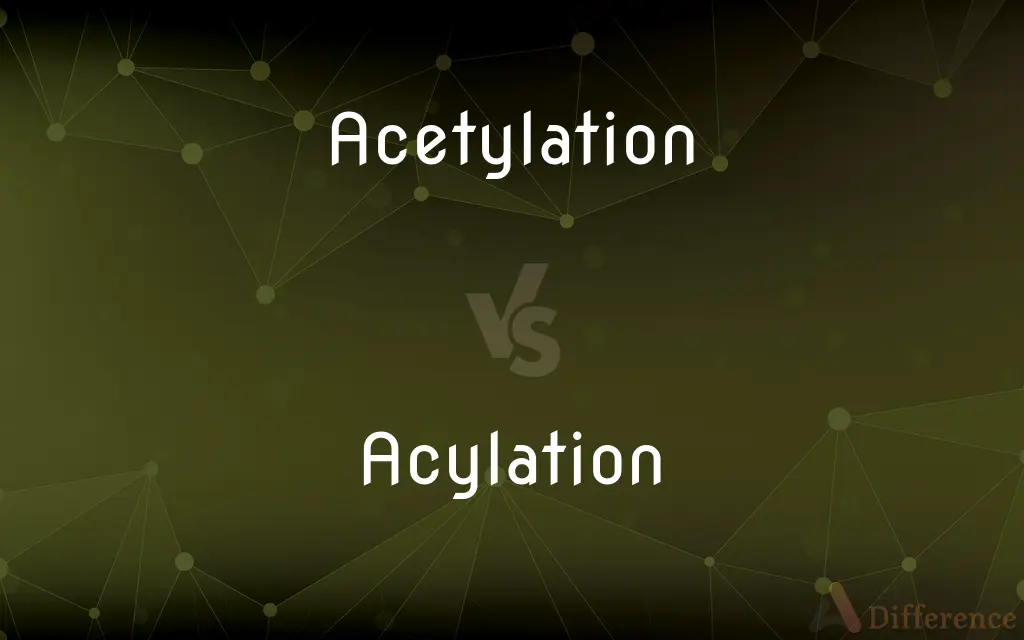Acetylation vs. Acylation — What's the Difference?
By Tayyaba Rehman — Published on November 20, 2023
Acetylation refers to the introduction of an acetyl group into a molecule. Acylation is the broader term for adding any acyl group to a molecule. Acetylation is a specific type of acylation.

Difference Between Acetylation and Acylation
Table of Contents
ADVERTISEMENT
Key Differences
Acetylation and Acylation, both are chemical processes that involve the addition of groups to a molecule. Acetylation specifically denotes the introduction of an acetyl group, which is characterized by the chemical formula -COCH₃, to another molecule. This can often be seen in organic chemistry and biochemistry, especially in reactions involving enzymes that add an acetyl group to molecules like proteins.
Acylation, on the other hand, is a more general term. It describes the process of adding an acyl group to a molecule. An acyl group has the general formula -COR, where 'R' can be any alkyl or aryl group. Therefore, while acetylation is always acylation because it involves adding an acyl group, not all acylations are acetylations.
In biological contexts, Acetylation has significant implications. For instance, the acetylation of histones in DNA can influence gene expression and regulate various cellular processes. On the flip side, Acylation, given its broader definition, can encompass a range of biological reactions, such as the acylation of proteins or enzymes which can modulate their activities.
One way to conceptualize the relationship between Acetylation and Acylation is to think of acetylation as a subset of acylation. Just as all squares (acetylation) are rectangles (acylation) but not all rectangles are squares, all acetyl additions are acyl additions, but not vice versa.
Comparison Chart
Definition
Addition of an acetyl group
Addition of any acyl group
ADVERTISEMENT
Group Introduced
-COCH₃
-COR (where R is any alkyl or aryl group)
Scope
Specific
General
Occurrence in Biochemistry
Histone acetylation, protein modifications
Protein/Enzyme modifications, fatty acid synthesis
Example
Acetylation of lysine residues in proteins
Formation of esters through fatty acid acylation
Compare with Definitions
Acetylation
Chemical modification involving an acetyl group.
Acetylation of certain proteins can alter cellular pathways.
Acylation
Reaction wherein -COR is attached to a substrate.
Acylation can produce a range of organic compounds.
Acetylation
Enzymatic addition of -COCH₃ to a substrate.
Enzyme-driven acetylation plays roles in metabolism.
Acylation
Can encompass acetylation as a specific subtype.
While acylation can be broad, acetylation is a specific instance.
Acetylation
Process of introducing an acetyl group into a molecule.
Histone acetylation can modulate gene expression.
Acylation
Broad chemical modification involving various acyl groups.
Different acyl groups can result in distinct acylation products.
Acetylation
Organic reaction resulting in the formation of an acetate ester.
Acetylation of an alcohol forms an acetate ester.
Acylation
Process of adding an acyl group to a molecule.
Acylation of amines forms amides.
Acetylation
Specific type of acylation with an acetyl group.
While acylation can vary, acetylation is precise.
Acylation
Often seen in formation of esters and amides in organic synthesis.
Acylation of alcohols with acyl chlorides produces esters.
Acetylation
To bring an acetyl group into (an organic molecule).
Acylation
(organic chemistry) The process of adding an acyl group to a compound.
Acetylation
(organic chemistry) The reaction of a substance with acetic acid or one of its derivatives; the introduction of one or more acetyl groups into a substance.
Acylation
The process of introducing an acyl group into a compound
Acetylation
The process of introducing an acetyl group into a compound;
The acetylation of cyclooxygenase-2 by aspirin
Common Curiosities
How is acylation different from acetylation?
Acylation refers to adding any acyl group, whereas acetylation is specific to adding an acetyl group.
What group is added during acetylation?
During acetylation, an acetyl group (-COCH₃) is added.
Why is acetylation important in biology?
Acetylation, especially of histones, plays a role in gene expression and protein function modulation.
What does an acyl group look like?
An acyl group has the formula -COR, where R can be any alkyl or aryl group.
Is acetylation a type of acylation?
Yes, acetylation is a specific type of acylation.
What are common reactions involving acylation?
Acylation reactions often involve formation of esters, amides, or ketones.
Is the enzyme catalyzing acetylation called an acetylase?
Yes, enzymes facilitating acetylation are often termed acetyltransferases or acetylases.
Can acetylation influence DNA structure?
Yes, histone acetylation can influence DNA packaging and accessibility.
Share Your Discovery

Previous Comparison
Cop vs. US Marshal
Next Comparison
Overloading in Java vs. Overriding in JavaAuthor Spotlight
Written by
Tayyaba RehmanTayyaba Rehman is a distinguished writer, currently serving as a primary contributor to askdifference.com. As a researcher in semantics and etymology, Tayyaba's passion for the complexity of languages and their distinctions has found a perfect home on the platform. Tayyaba delves into the intricacies of language, distinguishing between commonly confused words and phrases, thereby providing clarity for readers worldwide.












































